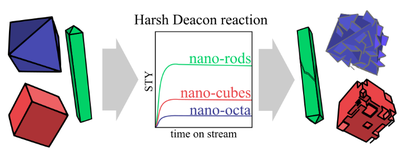März
Bild des Monats März 2018
Hier finden Sie wechselnde Einblicke in die Arbeiten der am LaMa beteiligten Arbeitsgruppen. Eine Sammlung aller bisher erschienenen Bilder finden sie in der Galerie der Bilder des Monats.
Shape-Controlled CeO2 Nanoparticles: Stability and Activity in the Catalyzed HCl Oxidation Reaction
CeO2 is a promising catalyst for the HCl oxidation (Deacon process) in order to recover Cl2. Employing shape-controlled CeO2 nanoparticles (cubes, octahedrons, rods) exposing facets with preferential orientations ((100), (111), (110)), we studied the activity and stability under two reaction conditions (harsh: Ar:HCl:O2= 6:2:2 and mild: Ar:HCl:O2=7:1:2). It turns out that both activity and stability are structure-sensitive and are not reconciled with corresponding surface energies and the formation energies of O-vacancies. The apparent activation energies are about 50 kJ/mol for cubes and rods, while the octahedrons reveal an apparent activation energy of 65 kJ/mol. The reaction order in O2 is positive (0.26-0.32). Under mild reaction conditions all three morphologies are stable, consistent with corresponding studies of CeO2 powders and CeO2 nanofibers. Under harsh reaction conditions, however, cubes and octahedrons are both instable, forming CeCl3, while rods are still stable. The present stability and activity experiments in the catalytic HCl oxidation reaction over shape-controlled CeO2 nanoparticles may serve as benchmarks for future ab-initio studies of the catalyzed HCl oxidation reaction over well-defined CeO2 surfaces.
Recent Publication on this Topic:
C. Li, Y. Sun, I. Djerdj, P. Vöpel, C. Sack, T. Weller, R. Ellinghaus, J. Sann, Y. Guo, B.M. Smarsly, H. Over, Shape-controlled CeO2 Nanoparticles: Stability and Activity in the Catalyzed HCl Oxidation Reaction, ACS Catal. 7 (2017) 6453-6463
Dieses Bild wurde eingereicht von Prof. Dr. Herbert Over.
